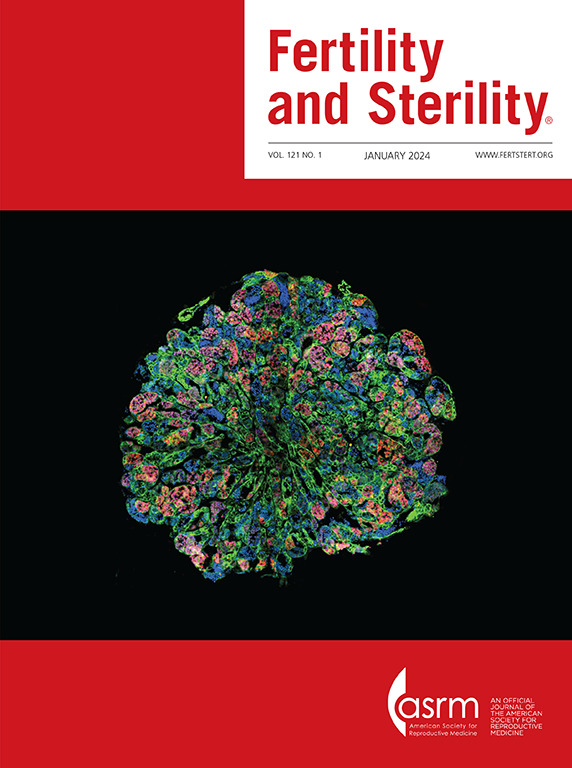Cine MRI of uterine peristalsis in patients with endometrial fibrosis.
IF 7
1区 医学
Q1 OBSTETRICS & GYNECOLOGY
引用次数: 0
Abstract
OBJECTIVE To assess uterine peristalsis using cine magnetic resonance imaging (MRI) in patients with different degrees of endometrial fibrosis. DESIGN A prospective observational cohort study. SUBJECTS A total of 75 patients with severe endometrial fibrosis, 40 patients with mild-to-moderate endometrial fibrosis, and 45 healthy women without uterine pathologies were included in the study. All patients of severe endometrial fibrosis and mild-to-moderate endometrial fibrosis were diagnosed by hysteroscopy. EXPOSURE Eligible women underwent MRI examination during the late proliferative phase. MAIN OUTCOME MEASURES Uterine static parameters including junctional zone thickness and its ratio to the total myometrial thickness, and cine parameters including peristaltic condition, frequency (/4min), intensity, and direction, were measured and analyzed. The study aimed to investigate the differences in uterine peristalsis across patients with different degrees of endometrial fibrosis using cine MRI. RESULTS Junctional zone thickness and its ratio to the total myometrial thickness were significantly higher in severe patients (6.1 mm, 95% Confidence Interval [CI]: 5.2-6.7 mm; 0.37±0.08) and mild-to-moderate patients (5.2 mm, 95% CI: 4.4-6.4 mm; 0.36±0.07) than in healthy women (3.9mm, 95% CI: 3.2-4.8 mm; 0.32±0.08) (all p <0.05). The percentage of detectable uterine peristalsis was significantly higher in healthy women (100%) than in severe patients (88.0%). Peristaltic frequency (/4min) and intensity were significantly higher in healthy women (10 times, 95% CI: 8-12 times; 3) than in mild-to-moderate patients (6 times, 95% CI: 4-9 times; 2) and severe patients (5 times, 95% CI: 4-7 times; 2) (all p <0.05).Mild-to-moderate patients and severe patients showed a higher percentage of the reverse and mixed peristaltic waves than healthy women (p <0.001). The degree of endometrial fibrosis was negatively correlated with peristaltic frequency and intensity but positively correlated with junctional zone thickness and its ratio to the total myometrial thickness (all p <0.05). The concordance of uterine static and cine parameters was excellent. CONCLUSION Cine MRI is particularly effective for assessing abnormalities in uterine peristalsis in patients with different degrees of endometrial fibrosis.子宫内膜纤维化患者子宫蠕动的MRI观察。
目的探讨不同程度子宫内膜纤维化患者的子宫蠕动情况。设计一项前瞻性观察队列研究。受试者共纳入75例重度子宫内膜纤维化患者、40例轻度至中度子宫内膜纤维化患者和45例无子宫病变的健康女性。所有重度和轻中度子宫内膜纤维化患者均通过宫腔镜诊断。暴露:符合条件的妇女在增生晚期接受MRI检查。主要观察指标:测量并分析关节区厚度及其与肌层总厚度之比等静态参数,以及蠕动情况、频率(/4min)、强度和方向等动态参数。本研究旨在探讨不同程度子宫内膜纤维化患者子宫蠕动的差异。结果重型患者(6.1 mm, 95%可信区间[CI]: 5.2 ~ 6.7 mm; 0.37±0.08)和轻中度患者(5.2 mm, 95% CI: 4.4 ~ 6.4 mm; 0.36±0.07)的连接带厚度及其与肌层总厚度之比均显著高于健康女性(3.9mm, 95% CI: 3.2 ~ 4.8 mm; 0.32±0.08)(均p <0.05)。健康妇女子宫蠕动检出率(100%)明显高于重症妇女(88.0%)。健康女性的肠蠕动频率(/4min)和强度(10次,95% CI: 8-12倍;3)显著高于轻中度患者(6次,95% CI: 4-9倍;2)和重度患者(5次,95% CI: 4-7倍;2)(均p <0.05)。轻至中度患者和重度患者的反向和混合肠蠕动波比例高于健康女性(p <0.001)。子宫内膜纤维化程度与蠕动频率、强度呈负相关,与连接带厚度及其与子宫内膜总厚度之比呈正相关(均p <0.05)。子宫静力学和力学参数一致性好。结论MRI对不同程度的子宫内膜纤维化患者的子宫蠕动异常评价特别有效。
本文章由计算机程序翻译,如有差异,请以英文原文为准。
求助全文
约1分钟内获得全文
求助全文
来源期刊

Fertility and sterility
医学-妇产科学
CiteScore
11.30
自引率
6.00%
发文量
1446
审稿时长
31 days
期刊介绍:
Fertility and Sterility® is an international journal for obstetricians, gynecologists, reproductive endocrinologists, urologists, basic scientists and others who treat and investigate problems of infertility and human reproductive disorders. The journal publishes juried original scientific articles in clinical and laboratory research relevant to reproductive endocrinology, urology, andrology, physiology, immunology, genetics, contraception, and menopause. Fertility and Sterility® encourages and supports meaningful basic and clinical research, and facilitates and promotes excellence in professional education, in the field of reproductive medicine.
 求助内容:
求助内容: 应助结果提醒方式:
应助结果提醒方式:


